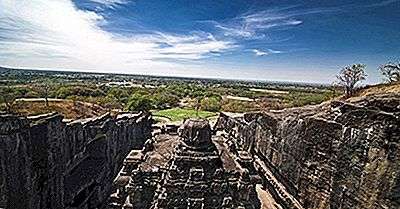
What is a monolithic building?
A monolithic building is a structure carved out of rock, carved out of a single piece of material such as stone. The building remains attached to the base of the solid rock from which it is cut. The building could also be cut out of an outcrop like the Shore temple in India, some buildings requiring careful inspection to reveal that they are monolithic. Monolithic architecture also includes monolithic domes, which are molded structures in one piece, either permanently or temporarily. Examples of monolithic buildings include Pancha Rathas, Kailasa temple and Shore temple in India, monolithic churches in Ethiopia and Theodoric mausoleum in Italy.
Kailasa Temple
The Kailasa temple is one of the oldest monolithic Hindu temples in Ellora, India. The building was carved out of a single rock and is considered one of the most beautiful cave temples due to its sculptural treatment, size and architectural design. It is one of the temples and monasteries of Cave 34 which collectively form the Ellora Caves. The construction of the Kailasa temple is linked to King Krishna I, King Rashtrakuta of the 10th century X who reigned between 8 and 756 CE. Its architecture shows traces of the Pallava and Chalukya styles. The temple houses several carefully carved panels depicting scenes from Ramayan and the adventures of Krishna. Monolithic pillars stand in the courtyard, framing the entrance on both sides.
History of the Kailasa temple
The commissioning and construction of the Kailasa temple are attributed to King Krishna I in AD 760. However, the attribution is not completely certain because the epigraphs connecting the temple to King Krishna are not physically connected to the caves. The temple combines a distinct architectural and sculptural design by combining it with its relatively large size. Its design and size led researchers to believe that the construction of the temple covered the reign of several kings. However, a large part of the temple was completed during the reign of Krishna I, parts of the temple being attributed to the last rulers. Evidence suggests that the entire temple was planned from the start and no part was an afterthought.
Construction technology and architecture
The temple of Kailasa is known for its vertical excavations. The sculptors may have started work on the top of the original rock and moved down. About 200,000 tonnes of rock had to be removed with a hammer and chisel before the temple took shape. Its architect is different from those of the Deccan region and seems to have been based on the Kailasa temple of Kanchi. The influence of the south on the temple suggests the involvement of artists Chalukya and Pallava in its construction. The deities at the entrance to the temple have Shaivaite and Vaishnavaite sects on the right and left respectively. The courtyard is U-shaped and reveals a two-story walkway. A central shrine dedicated to Shiva is located in the center of the courtyard. The sanctuary has a flat-roofed mandapa supported by 16 pillars. Scenes from Ramayan and Mahabharat are presented at the base of the temple hall. Overall, the Kailasa Temple is an engineering marvel that was executed from top to bottom with zero margin of error.
